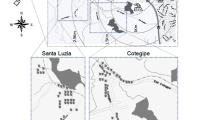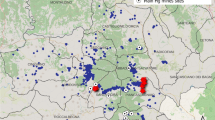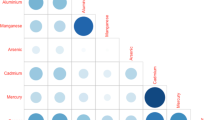Abstract
Arsenic (As), cadmium (Cd), lead (Pb), mercury (Hg), beryllium (Be), nickel (Ni), selenium (Se), and thallium (Tl) are reportedly notorious toxic contents of make-ups, with potential to cause cancer and chronic kidney disease, warranting investigation on their toxic effects. One hundred female university students were randomly selected as consistent users of make-ups for upward of 3 years. The serum/urine levels of the 8 elements were regressed against the kidney functions (estimated glomerular rate, eGFR) of the subjects. At coefficient of − 0.009, As had insignificant (0.518) level. The coefficient for Cd was − .155 and insignificant (0.423). At coefficient of − 039, Pb level was insignificant (0.595). The coefficient, 0.061, for Hg was insignificant (0.462). At − 1.585, the coefficient of Be was insignificant (0.292). The coefficient for Ni, 1.384, was insignificant (0.354). At − .002, the coefficient of Se was insignificant (0.635). The coefficient, 0.039, for Tl was significant at 5% (0.015). This finding internally validated the mean serum Tl level, 201.4900 ± 20.63316 μg/L, which was much higher than the normal level of < 2 µg/L and within the toxic range of > 200 µg/L. A policy is needed to address the use of make-ups containing Tl.
Similar content being viewed by others
Data Availability
Materials and data embedded in this work are transparently available.
Code availability
Materials and data are in Microsoft Word with custom code.
References
Agency for Toxic Substances and Disease Registry, ATSDR. (2002). Public health statement for beryllium. https://www.atsdr.cdc.gov/phs/
Agency for Toxic Substances and Disease Registry, ATSDR. (2000). Toxicological profile for arsenic. Public Health Service, U.S. Department of Health and Human Services.
Aldayel, O., Hefne, J., Alharbi, K. N., & Al-Ajyan, T. (2018). Heavy metals concentration in facial cosmetics. Natural Products Chemistry & Research, 6, 303.
Bakırdere, S., Yaroğlu, T., Tırık, N., Demiröz, M., Fidan, A. K., Maruldalı, O., Karaca, A. (2013). Determination of As Cd, and Pb in Tap Water and Bottled Water Samples by Using Optimized GFAAS System with Pd-Mg and Ni as Matrix Modifiers, Journal of Spectroscopy, https://doi.org/10.1155/2013/824817
Becker, L. C., Boyer, I., Bergfeld, W. F., Belsito, D. V., Hill, R. A., et al. (2016). Safety assessment of alumina and aluminum hydroxide as used in cosmetics. International Journal of Toxicology, 35(3 suppl), 16S-33S.
Brown, V. J. (2013). Metals in lip products: a cause for concern? Environmental Health Perspectives, 121(6), A196.
Bruzzoniti, M. C., Abollino, O., Pazzi, M., Rivoira, L., Giacomino, A., et al. (2017). Chromium, nickel, and cobalt in cosmetic matrices: an integrated bioanalytical characterization through total content, bioaccessibility, and Cr (III)/Cr (VI) speciation. Analytical and Bioanalytical Chemistry, 409(29), 6831–6841.
Capelli, C., Foppiano, D., Venturelli, G., Carlini, E., Magi, E., et al. (2014). Determination of arsenic, cadmium, cobalt, chromium, nickel, and lead in cosmetic face-powders: optimization of extraction and validation. Analytical Letters, 47, 7.
Chan, T. Y. K., Chan, A. P. L., & Tang, H. L. (2019). Nephrotic syndrome caused by exposures to skin-lightening cosmetic products containing inorganic mercury. Clinical Toxicology (philadelphia, PA), 17, 1–7.
Doshi, M., Annigeri, R. A., Kowdle, P. C., Subba Rao, B., & Varman, M. (2018). Membranous nephropathy due to chronic mercury poisoning from traditional Indian medicines: report of five cases. Clinical Kidney Journal, 12(2), 239–244.
Fevrier-Paul, A., Soyibo, A., Mitchell, S., & Voutchkov, M. (2018). Role of toxic elements in chronic kidney disease. Journal of Health and Pollution, 8(20), 181–202. https://doi.org/10.5696/2156-9614-8.20.181202
Ghaderi, A., Banafshe, H.R., Khodabandehlo, S., Mehrzad, F., Mehrpour, O., & Afshar, R. (2017). Electron Physician, 9(4), 4190–4194. https://doi.org/10.19082/4190
Gondal, M. A., Dastageer, M. A., Naqvi, A. A., Isab, A. A., & Maganda, Y. W. (2012). Detection of toxic metals (lead and chromium) in talcum powder using laser induced breakdown spectroscopy. Applied Optics, 51(30), 7395–7401.
Hall, J., & Hall, J. (2011). Guyton, Hall Textbook of Medical Physiology (12th ed.). Elsevier.
Henn, C. B., Ettinger, A. S., Hopkins, M. R., Jim, R., Amarasiriwardena, C., et al. (2016). Prenatal arsenic exposure and birth outcomes among a population residing near a mining related superfund site. Environmental Health Perspectives, 124(8), 1308–1315.
Klotz, K., Weistenhöfer, W., Neff, F., Hartwig, A., Van Thriel, C., et al. (2017). The health effects of aluminum exposure. Deutsches Ärzteblatt International, 114(39), 653–659.
Lavilla, I., Cabaleiro, N., Costas, M., de la Calle, I., & Bendicho, C. (2009). Ultrasound- assisted emulsification of cosmetic samples prior to elemental analysis by different atomic spectrometric techniques. Talanta, 80(1), 109–116.
Li, H., Zheng, J., Wang, H., Huang, G., Huang, Q., et al. (2019). Maternal cosmetics use during pregnancy and risks of adverse outcomes: a prospective cohort study. Science and Reports, 9(1), 8030.
Martin, C. J., Werntz, C. L., 3rd., & Ducatman, A. M. (2004). The interpretation of zinc protoporphyrin changes in lead intoxication: a case report and review of the literature. Occupational Medicine (london), 54(8), 587–591.
Moatkhef, F., Ismail, H., Agamy, N., & Aborhyem, S. (2020). Quantitative determination of selenium in the most common food items sold in Egypt. The Journal of the Egyptian Public Health Association, 95, 15. https://doi.org/10.1186/s42506-020-00044-z
Mohiuddin, A. K. (2019a). Cosmetics in use: a pharmacological review. Journal of Dermatology & Cosmetology, 3(2), 50–67.
Mohiuddin, A. K. (2019b). Skin lighteners, hyperpigmentation management. ASIO Journal of Pharmaceutical, Herbal Medicines Research (ASIO-JPHMR) Volume, 5, 1.
Mohiuddin, A. K. (2019c) Heavy Metals in cosmetics: the notorious daredevils and burning health issues. American Journal of Biomedical Science and Research, 4, 332–337. AJBSR.MS.ID.000829. https://doi.org/10.34297/AJBSR.2019.04.000829
National Institute for Occupational Safety and Health (NIOSH), Center for Disease Control (CDC). (2003). Thallium: Systemic agent. https://www.cdc.gov/niosh/ershdb/emergencyresponsecardThalliumbloodconcentrationlevels
Orisakwe, O. E., & Otaraku, J. O. (2013). Metal concentrations in cosmetics commonly used in Nigeria. The Scientific World Journal, 5, 959637.
Orr, S. E., & Bridges, C. C. (2017). Chronic kidney disease and exposure to nephrotoxic metals. International Journal of Molecular Sciences, 18(5), E1039.
Piao, F., Yokoyama, K., Ma, N., & Yamauchi, T. (2003). Subacute toxic effects of zinc on various tissues and organs of rats. Toxicology Letters, 145(1), 28–35.
Qin, A. B., Su, T., Wang, S. X., Zhang, F., Zhou, F. D., et al. (2019). Mercury-associated glomerulonephritis: a retrospective study of 35 cases in a single Chinese center. BMC Nephrology, 20(1), 228.
Saadatzadeh, A., Afzalan, S., Zadehdabagh, R., Tishezan, L., Najafi, N., et al. (2019). Determination of heavy metals (lead, cadmium, arsenic, and mercury) in authorized and unauthorized cosmetics. Cutaneous and Ocular Toxicology, 38(3), 207–211.
Shabani, A. M. H., Dadfarnia, S., Shahbaazi, Z., & Jafari, A. A. (2008). Extraction-spectrophotometric determination of nickel at microgram level in water and wastewater using 2-[(2-mercaptophenylimino)methyl]phenol. Bulletin of the Chemical Society of Ethiopia, 22(3), 323–329.
Safaralizadeh, R., Kardar, G. A., Pourpal, Z., Moin, M., & Zare, A. (2005). Teimourian S (2005) Serum concentration of selenium in healthy individuals living in Tehran. Nutrition Journal, 4, 32. https://doi.org/10.1186/1475-2891-4-32
Sani, A., Gaya, M. B., & Abubakar, F. A. (2016). Determination of some heavy metals in selected cosmetic products sold in Kano metropolis, Nigeria. Toxicology Reports, 3, 866–869.
SCOOPWHOOP. (2017). Not just Virat Kohli, here are other celebs who said no to endorsements on ethical grounds.
Sneyers, L., Verheyen, L., Vermaercke, P., & Bruggemann, M. (2009). Trace element determination in beauty products by k0-instrumental neutron activation analysis. Journal of Radioanalytical and Nuclear Chemistry, 281, 259–263.
Tibau, A. V., & Grube, B. D. (2019). Mercury contamination from Dental Amalgam. Journal of Health and Pollution, 9(22), 190612.
Wang, Y., Chen, L., Gao, Y., Zhang, Y., Wang, C., et al. (2016). Effects of prenatal exposure to cadmium on neurodevelopment of infants in Shandong, China. Environmental Pollution, 211, 67–73.
Wani, A. L., Ara, A., & Usmani, J. A. (2015). Lead Toxicity: a Review. Interdisciplinary Toxicology, 8(2), 55–64.
Zhang, L., Liu, F., Peng, Y., Sun, L., & Chen, C. (2014). Nephrotic syndrome of minimal change disease following exposure to mercury-containing skin-lightening cream. Annals of Saudi Medicine, 34(3), 257–261.
Author information
Authors and Affiliations
Contributions
Not applicable; single author, who did all the work.
Corresponding author
Ethics declarations
Ethical approval
The Health Research and Ethical Review Committee of the University of Nigeria Teaching Hospital (UNTH), Ituku-Ozalla, Enugu approved the study.
Consent to participate
All subjects gave informed consent to participate in the study.
Consent for publication
All the subjects gave informed consent for academic publishing of the results of the study with anonymity.
Competing interests
The author declares no competing interests.
Additional information
Publisher's Note
Springer Nature remains neutral with regard to jurisdictional claims in published maps and institutional affiliations.
Rights and permissions
About this article
Cite this article
Eneh, O.C. Toxic effects of selected trace elements contained in make-ups on female university students in Nigeria. Environ Monit Assess 193, 412 (2021). https://doi.org/10.1007/s10661-021-09161-4
Received:
Accepted:
Published:
DOI: https://doi.org/10.1007/s10661-021-09161-4




